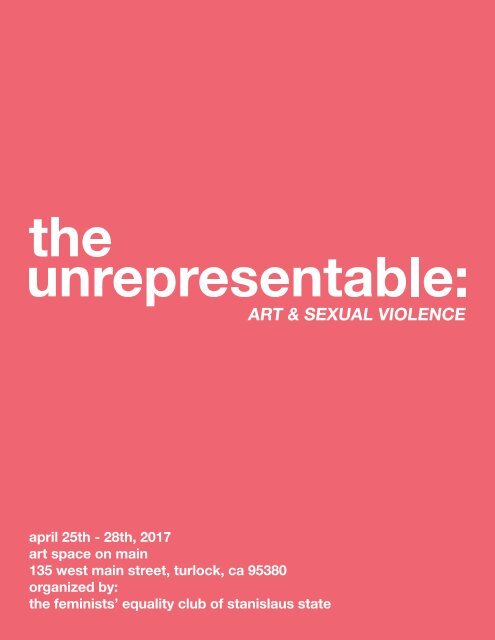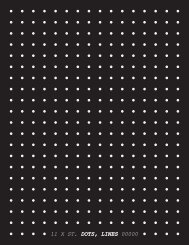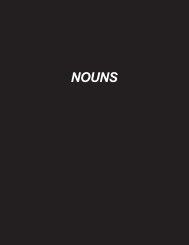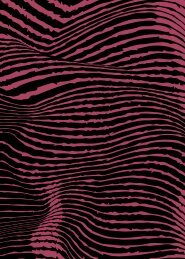The Unrepresentable: Art & Sexual Violence
Create successful ePaper yourself
Turn your PDF publications into a flip-book with our unique Google optimized e-Paper software.
<strong>The</strong> <strong>Unrepresentable</strong>: <strong>Art</strong> & <strong>Sexual</strong> <strong>Violence</strong><br />
April 25th - 28th, 2017<br />
<strong>Art</strong> Space on Main<br />
135 West Main Street<br />
Turlock, CA 95380<br />
Exhibition Organized by:<br />
<strong>The</strong> Feminists’ Equality Club of Stanislaus State and Dr. Staci Gem Schiewiller<br />
Exhibition was funded by:<br />
Associated Students Inc. (ASI), <strong>The</strong> Feminists’ Equality Club of Stanislaus State and<br />
Dr. Staci Gem Schiewiller<br />
table of<br />
contents<br />
Introduction by Tinna Savini<br />
Paul Acevedo<br />
Christopher Benson<br />
Madison Bettencourt<br />
Timothy Brown Jr.<br />
Noelani Daniel-Gomes<br />
2<br />
4<br />
6<br />
8<br />
10<br />
12<br />
Maritza Diaz<br />
14<br />
Acknowledgments:<br />
Associated Students Inc. (ASI), Dean De Cocker, Matt Sahlit, Dr. Trystan Cotten, Tinna<br />
Savini, Nikki Boudreau, Andrew Cain, and CSU Stanislaus <strong>Art</strong> Department.<br />
Alyssa Moon<br />
Nieko McDaniel<br />
16<br />
18<br />
Tinna Savini<br />
22<br />
Copyright © 2017 <strong>The</strong> Feminists’ Equality Club of Stanislaus State and Dr. Staci Gem<br />
Schiewiller<br />
Hayley Simon<br />
Natalie Wadlington<br />
24<br />
26<br />
Kolaya Wilson<br />
28<br />
Brentt Wong<br />
30<br />
Catalogue Design: Matt Sahlit<br />
Catalogue Photography: Maggie Gonzales<br />
Opening Night<br />
Feminists’ Equality Club Officers<br />
32<br />
34<br />
Photographs included were taken and used under the permission of the artists.<br />
1
Vision in the <strong>Unrepresentable</strong><br />
By: Tinna Savini, MFA<br />
<strong>Unrepresentable</strong>: (Adj.) not capable of being represented.<br />
Origin: mid-17th century from un + representable<br />
(Oxford English dictionaries online)<br />
<strong>The</strong> <strong>Unrepresentable</strong>: <strong>Art</strong> and <strong>Sexual</strong> <strong>Violence</strong> is the second art exhibition, organized<br />
by the CSU Stanislaus Feminists’ Equality Club, in which students, faculty, and exhibitors<br />
once again joined their voices with many other campuses, institutions, organizations,<br />
survivors, and activists whose purpose is to raise awareness of the sexual violence too<br />
painfully frequent in global society. As the exhibition title suggests, most of the works shown<br />
in “<strong>Unrepresentable</strong>” attempt to picture those things we are not capable of representing or<br />
comprehending with respect to the inhumanity connected to sexual assault and violence. In<br />
the show we see visualized some of the solipsistic pathologies that can lead a person to so<br />
disengage and to violate the reality of another person as to cause her/him physical violence<br />
or psychological harm. Although the truth of such realities exists in life and in images, this<br />
exhibition also speaks of the resilience of individual voices and collectively of images that<br />
seed hope in the potentially cathartic effect of giving form to experience. In this way, these<br />
efforts are not mere reportage of the meanness too often felt in our culture; rather, they<br />
bring to consciousness a culture more humane and based on the realization of respect and<br />
kindness toward ourselves and all other beings with whom we share this planet.<br />
Many of the works visually reveal the intimate content of pain, fear, and suffering.<br />
Images of bruised faces and hands, absent gazes, uncomfortably close touches from hands<br />
not one’s own, blood, and exposed women’s bodies align with the broader theme addressing<br />
the issues of violence and sexual assault in our society. <strong>The</strong>se images show that violence,<br />
sexual assault, and the ignorance of societal attitudes that attend such aggressions leave the<br />
raw emotions of personal experiences unattended like free radicals waiting to congregate<br />
into a cancer. <strong>The</strong> eruption of negative emotions and the violence that often attends them<br />
are common enough that we need little explanation for some works. In one photograph by<br />
Brentt Wong, Love Note (2017), we see two small pictures of a beautiful young woman’s<br />
face set above a note with a few clearly legible handwritten sentences. We know that the<br />
scrap of paper with text commenting on her appearance has actually been a precursor to<br />
her assault. If we have any doubt, we need only look at the visual evidence of the large<br />
black-and-blue bruising that her eye shows us. We know that the pictures of her taken<br />
frontally and in profile are the kinds of views that are taken during a police report or clinical<br />
examination. We shake our heads with the familiarity of knowing for ourselves, or from<br />
someone close to us, that this is a custom so often passed down and too long tolerated. In<br />
another image by Hayley Simon, Medusa (2017), we see the closed composition of a nude<br />
female figure whose posture is contracted and whose head sinks between her two crossed<br />
2<br />
arms. Her long, wind-blown hair flies up like a Gorgon vision, but instead of a source of<br />
female power, all one can see is sorrow, much like the drawing of the same title by Van Gogh<br />
of his lover Sien Hoornik (1882), slumped in dejected form.<br />
Two works, which both address unwelcome touches, share content and polyptych<br />
form but do not use the same medium. In the first work by Natalie Wadlington entitled Two<br />
Acts (2016), two small, robustly-painted canvasses are juxtaposed, and each provides a<br />
view of Philip Guston-like thin, naked, prickly-haired teenage arms and legs whose genders<br />
appear to be that of a boy and a girl. <strong>The</strong> mingled body parts between the two images<br />
express the awkwardness of a pressured sexual advance. While in the quadriptych work<br />
by Christopher Benson, Affect/Effect (2017), the medium of the print serves to negate<br />
the intimate warmth of the painterly approach in the first picture, which heightens the<br />
awkwardness and anxiety one feels when looking at it. <strong>The</strong> repetition of the four pictures<br />
of the same image placed side by side shows a large hand and partial arm touching the<br />
asymmetrically-placed disembodied face of a beautiful young woman. <strong>The</strong> hand is not that<br />
of the woman; in fact, we see nothing of her body beyond her face. In each of the prints,<br />
her wide-open eyes are somewhat obscured by the clear glasses she wears. Yet the woman<br />
does not seem alive by having her own body or eye function but only by the connection<br />
of the hand to her face. Her realness is reduced to a fetishized memento, which is further<br />
enforced by the smaller images of other young women in collage formed all around her face.<br />
In the top pair, the word “GAZE” handwritten under one image and the word “BLEED” under<br />
the second image of the four images cause one to wonder if we are seeing through the eyes<br />
of a voyeur and/or perpetrator.<br />
<strong>The</strong> content of some works addresses the more general theme of “Take Back the<br />
Night,” the international event and nonprofit national organization whose mission it is<br />
to make the world a safe enough place for women to walk alone at night without fear of<br />
violence or molestation. In Kolaya Wilson’s Becoming Alive Again (2017), a watercolor image<br />
of a tiny headless female torso with arms in a prayer position is placed at the center of a<br />
larger circle in the middle of a rectangular format. <strong>The</strong> thin headless figure is not a horror,<br />
but rather reminds one of the headless fertility pendants of prehistoric times. <strong>The</strong> tiny torso<br />
image beckons us to envision our own heads atop the figure as it sits surrounded by the<br />
curvilinear vines that form a symmetrical tree design. Below this are two triangular shapes<br />
of green as fresh and verdant as the fresh growth of the seed-like center. Above in the upper<br />
third of the image, coming from both the left and right corners and stretching inward, are<br />
sturdy branches with lotus blossoms that compositionally conclude a diamond shape that<br />
focuses the eye once again on the center of the tendril tree and mythic mother torso. This<br />
is a memorable visualization that is like a vehicle we might use to realize a more kind and<br />
conscious culture, free of sexual assault and all that is unpresentable in sexual and other<br />
violence.<br />
3
paul<br />
acevedo<br />
My piece appropriates the narrative of the<br />
Spanish song that my parents would sing to me<br />
and my brothers when we were little, “[D]uérmete<br />
niño duérmete ya, que viene el coco, y te comerá.”<br />
It translates, “[S]leep boy, sleep now, the Coco is<br />
coming, and he’ll eat you up.” This in an attempt to<br />
draw a connection to the challenges faced by women<br />
and men during the night. It is a personal response<br />
to the idea of keeping a person away from danger by<br />
singing the song and scaring the person from staying<br />
up all night. My work invites the viewer to stand up<br />
and to take back the night by not being afraid to stand<br />
up for equality.<br />
4<br />
Coco nunca más!, Linocut triptych, 2017, 5x6”<br />
5
christopher<br />
benson<br />
One subject that I needed to acknowledge<br />
this year was the representation of Asian-American<br />
women in media and culture. In American popular<br />
culture, Asians and Asian Americans are categorized<br />
and mislabeled and fall into tropes that have been<br />
accepted widely in the media. This all came in<br />
retrospect to an Ethnic Studies class I took last Fall<br />
2016. I had my eyes opened in that class. I became<br />
aware to the origins as to why Asian/Asian-American<br />
peoples have been portrayed so negatively in popular<br />
culture.<br />
<strong>The</strong> images produced have to do with the figural<br />
saturation, sublimation, and social integration that are<br />
expected of Asian-American women. How can one<br />
assimilate into a culture that still recognizes one as<br />
alien without completely abandoning what makes one<br />
special?<br />
6<br />
Affect/Effect, Screen Print, 2017, 4 prints measuring 11x14”each<br />
7
madison<br />
bettencourt<br />
Working with a range of materials, I am inspired<br />
by the ideals and stories of my immigrant grandmother<br />
and the experiences of sexual assault and abusive<br />
relationships. Exploring societal and contemporary art<br />
issues of gender and identity, I apply this background<br />
to my artwork. Through exploration of form and color,<br />
I utilize found objects and their perceived meanings<br />
as ways to critique such ideas as they may apply to<br />
the viewer. Beginning with the memories of both my<br />
grandmother and myself, I aim to incorporate elements<br />
of found imagery and color through my artwork in a<br />
way that can create a broader connection with my<br />
piece and the viewer’s understanding.<br />
8<br />
That Night, Mixed Media, 2017, 66”x13”x2”<br />
9
timothy<br />
brown jr.<br />
What is it about a story that eclipses space and time?<br />
Sitting and listening to a person speak of a mythical world<br />
surrounded by good and evil, morals, and lessons, it is here<br />
that we gain an understanding of our surroundings. From our<br />
first days on this planet we are read epic tales of heroes and<br />
villains, kings and queens, old beggars, and wicked witches, but<br />
when we grow to a certain age, suddenly adulthood steps in and<br />
pushes these fantastical narratives aside for what is considered<br />
real life. It is here that my work will push back.<br />
Like so many, I have experienced some of the best and<br />
worst of times, and it is here that I begin to create these narratives,<br />
which encompass what would typically be swept under the<br />
rug. It is with consideration and awareness that I remove this<br />
rug and expose these serious issues in the guise of a fairy tale.<br />
Issues, such as addiction, domestic violence, acceptance, race,<br />
manipulation, sexual orientation, love, and finding a balance<br />
between the light and dark side of human nature, are crucial and<br />
delicate topics, requiring a dignified treatment, but necessary for<br />
discussion.<br />
Each narrative plays out in its own unique dramatic<br />
fashion, allowing the severity of the topic to shine through,<br />
beyond the weird and wondrous imagery. Like the tales that came<br />
before, every new story has a lesson that must be understood. It<br />
is important for the viewer to be willing to open his/her mind and<br />
to accept this seemingly childish construct, all the while reading<br />
material that is not meant for children.<br />
10<br />
<strong>The</strong>re is darkness that resides in each and every one<br />
of us. While some would rather pretend that it does not exist,<br />
I know that it is there, lurking behind a door, seemingly buried<br />
underneath the ice, and scratching at the surface. It is these<br />
deep-seeded emotions and feelings that act as catalysts for<br />
my fairy tales. I want the viewer to take away whatever s/he can<br />
from this work, if it helps him/her to understand that what s/he is<br />
experiencing to be genuine and that his/her feelings are valid.<br />
It is important to note that it is only through the dark that we can<br />
experience the light, and it is only by experiencing brief moments<br />
of pain that we can indulge in pleasure. Cautionary Affection, Oil on Panel, 2017, 24” x 24”<br />
11
noelani<br />
daniel-gomes<br />
I wrote poem after a friend breached a definite<br />
line with me. It was while I was alone with him in a<br />
city hours away from home. It had never happened<br />
before, and I was stunned. It came up again later, and<br />
he laughed, saying we were both drunk—when I was<br />
not. Although he does not know my feelings about that<br />
night even now, the poem was a balm for my troubled<br />
mind. He has since moved on, but I will always carry<br />
a part of that girl who hid in the red-colored bathroom<br />
and cried.<br />
Quiet<br />
We must be quiet in this place.<br />
<strong>The</strong>se catacombs of rights and powers<br />
strip supposed Amazons of strength—<br />
inspire suffering<br />
in spite of suffrage.<br />
<strong>The</strong> quiet isn’t revenge.<br />
It isn’t consent.<br />
This quiet is not folly, lunacy, or hysteria.<br />
It is not inebriation.<br />
Not drunk on lack of touch, of yielding to strong hands.<br />
It is fear.<br />
Unthinking arms, a cage<br />
with metal walls that my voice dies within,<br />
in a breathless, hitching way—<br />
but it is no compliment to you.<br />
Trust is a dangerous commodity,<br />
with so much counterfeit and debt.<br />
In pain, I took your hand, seeking help—<br />
bankrupting myself—<br />
and still you collected interest.<br />
Your hands wandered, like a miser over treasure—<br />
a drugstore statue-turned-idol<br />
with the help of liquor.<br />
This tipple-touch is poisonous,<br />
lingering for months like a cancer in my throat<br />
that grows when I’m forced to smile—<br />
to play at normalcy with you.<br />
We ignore the sore between us—<br />
this Cold War tête-à-tête, all friction and no feeling.<br />
You laugh when you remember, and I laugh, too.<br />
I have to.<br />
12<br />
We must be quiet in this place.<br />
13
maritza<br />
diaz<br />
This semester I have been trying out a new<br />
direction through painting and printmaking, and while<br />
going down this path, I have discovered something<br />
that I am passionate about. I am passionate about<br />
showing the truth through imagery and text that allow<br />
viewers to see what I have gone through as a woman<br />
growing up today and also other women’s experiences.<br />
I want to evoke emotion in viewers so that they can<br />
also experience that exact feeling that was felt in that<br />
exact moment in time so that we realize we are not<br />
so different after all and should be supporting each<br />
other regardless of gender and ethnicity. We are in a<br />
time in society when we need to be together and even<br />
stronger as one.<br />
<strong>The</strong> techniques that I use to portray my imagery<br />
are through composition, color, and text to effect<br />
viewers so that they can come to understand and to<br />
appreciate my work. When it comes to showing that<br />
truth to viewers, I do not allow myself to hold back,<br />
because as artists, I believe we should not let ourselves<br />
be censored by audiences who want to avoid or to<br />
hide it. This world has never been innocent, and I do<br />
not want to conform to what society “thinks” I should<br />
portray.<br />
14<br />
Daily Experiences, Screen Print, 2017, 11x14” (Top)<br />
It’s All Your Fault, Screen Print, 2017, 11x14” (Bottom)<br />
15
alyssa<br />
moon<br />
Much of my artwork deals with reflections of<br />
past experiences and how I deal with them presently.<br />
Growing up with domestic violence under a patriarchal<br />
dominion has resulted in sadness and revolt in my<br />
work. Depression, isolation, fear of love, distrust,<br />
endurance, independence, and strength are some of<br />
the feelings explored through my work. I attempt to pull<br />
strength from my past with my artwork but also talk<br />
about the intimate things that happen within myself,<br />
as well as others who suffer quietly in violence and<br />
how it follows them throughout life. My hope is that<br />
I am giving a voice to the mothers who do not have<br />
the strength to leave and to comfort survivors. Taking<br />
back the night is important to me, because we should<br />
not have to fear anything as women. We are powerful.<br />
16<br />
I Stand, Acrylic on Paper 2017 Approx. 24x 11” (Top)<br />
He Took Away My Heartstrings, Assemblage/Wood, 2017, Approx. 12in x 6in (Bottom)<br />
17
nieko<br />
mcdaniel<br />
<strong>The</strong> poem “Acid,” which was inspired by a<br />
heartbreak that I personally endured, is an example of<br />
my thought process on ascertaining the root of issues<br />
that would lead to the heartbreak between a person<br />
and me. From critically accessing the experience to<br />
a basic form, I identified the problem as trauma that<br />
others have caused us in the past. Trauma can be<br />
a cycle, in which the offended can be the offender.<br />
In turn we can become the monsters that we most<br />
resent. <strong>The</strong> use of the word “acid” and the types of<br />
acid are symbolic and metaphorical. My goal in writing<br />
the poem was to speak to the reader and say be<br />
careful of what you do, be mindful of your actions, and<br />
be considerate of others as you do not and would not<br />
like others to disrespect you in any form, so why do it<br />
to others? Acid is in a way a poem of the golden rule.<br />
At the end of the poem, I tell the reader to break the<br />
cycle of trauma that people are victims of.<br />
Acid Rain<br />
<strong>The</strong> rain pours, it burns<br />
Feeling the scorn of outside influences<br />
<strong>The</strong> pain from their reign, the pain of the rain<br />
An empath<br />
Weathering the rain, the storm, the pain with them, for them, because of them<br />
Soaking it in<br />
Bathing in it<br />
Drinking it in<br />
To take all away from them<br />
Becoming a pool<br />
Olympic size<br />
Beginning to overflow<br />
A dam, on the verge of bursting<br />
A sponge can only hold so much liquid<br />
Trying to wring yourself out<br />
<strong>The</strong> only way to let it out<br />
Is to sweat, cry, and spit it out<br />
Until you dry yourself out<br />
In this sense, is it unhealthy to want to achieve dehydration?<br />
Acid Sweat<br />
It seems from the Acid Rain that acid sweat occurs<br />
Probably because it is hot and burns<br />
Humidity of the air, feeling the temperature rising<br />
Sticky from the rain, but also your own sweat<br />
<strong>The</strong> two are mixing; it is hard to tell which is which<br />
<strong>The</strong> pain from the rain makes you sweat, because you are weathering it<br />
<strong>The</strong> rain pouring down is not your fault, but it makes you work that much harder<br />
It makes you sweat<br />
Now the burn is coming from your own skin, your own work<br />
Putting out so much energy, and more sweat runs<br />
It is an infection, starting from your head, spreading to your toes<br />
You are beginning to dehydrate<br />
<strong>The</strong> liquid running off your skin<br />
But it is no longer just the pain of the rain<br />
It is also the pain of your sweat<br />
And it is because of your weathering the pain<br />
That in turn creates your own pain from within<br />
But pain.... Pain also creates tears<br />
18<br />
19
Acid Spit<br />
Acid Tears<br />
One by one more forces are weighing down on you<br />
<strong>The</strong> pain of the rain from their reign<br />
<strong>The</strong> pain of your sweat<br />
But pain is pain... and it hurts<br />
Pain creates tears, tears of acid<br />
And these tears of acid burn because of the pain you are taking from the rain and the pain<br />
of putting out your own sweat<br />
Pain has generated from pain and is creating more pain<br />
It is a cycle<br />
You are becoming dehydrated<br />
Tears running from tears and creating more tears<br />
Crying because you are crying<br />
But then you begin to start drying because you are crying, sweating, and the rain keeps<br />
running off your skin<br />
But it is still pain, it still burns<br />
<strong>The</strong> pain from all forces starts to make your mind go insane<br />
Your pain creates animosity toward all the inflicted pain on yourself<br />
Hatred<br />
<strong>The</strong> pain makes you full of pain, Pain-full<br />
But you no longer want to weather this pain alone<br />
Now you want to inflict pain<br />
So others will also weather the same<br />
So now you spit, you spit the spit of acid<br />
Now the pain is coming from you in the most disgusting way<br />
Because of the pain of the rain from their reign, your sweat...your tears<br />
So why care if you spit acid?<br />
It is just another way to get rid of your pain?<br />
So you get rid of the pain by spitting<br />
What is it more to get rid of the pain by spitting since you have already been weathering the<br />
rain, sweat, and tears?<br />
You only want to do it YOUR way to get rid of the pain<br />
And it seems like the only way to obtain.... Dehydration<br />
But you do not realize that you are starting to spit on others, spitting the spit of acid<br />
You are becoming what you resented from others, what they had done to you<br />
You are becoming the acid rain to others because you spit<br />
You spit on their heads<br />
No need for pissing acid, because acid spit works just as good<br />
Wrongfully used as if to release acid piss<br />
Now you have become the pain of the acid rain. Inflicting pain on them<br />
Your reign of acid rain is the pain others now fear<br />
See it is a cycle<br />
<strong>The</strong> spit became because of your tears<br />
Behind all anger is sorrow<br />
Creating your tears and fears<br />
Your tears of acid<br />
It can create the cycle in you again<br />
So then it all eventually turns back into acid spit<br />
And that acid spit becomes the acid rain on people’s heads<br />
Pain.... Pain of the rain, sweat, tears, then spit, then rain, then sweat, then tears, then spit,<br />
then rain, then sweat, then tears, then spit!<br />
But tears are the worst<br />
You do not like them yourself<br />
So why give them to others?<br />
Do not spit acid rain, do not spit at all<br />
See it is a cycle<br />
And it is up to you to keep the cycle going<br />
Or break the cycle...<br />
Break it through Dehydration<br />
20<br />
21
tinna<br />
savini<br />
A general theme in my work is the observation of<br />
emergent patterns and how the accumulated relationships of<br />
those patterns are contained for examination in a pictorial space.<br />
This is somewhat like capturing an inflight creature for a closer<br />
look before in your open hand it flies away. Traditional means<br />
and methods are relied on in the pairing of painted, verticallyoriented,<br />
slight rectangles and longer, clearly horizontal,<br />
rectangular canvases. In the vertical panels, a human presence<br />
is meant to be invoked while the longer horizontal panels offer<br />
the subject of landscape--not as much as a natural passage but<br />
as a perceptual one. Whether human or natural, the forms seek<br />
definition from each other as boundaries and borders, “self and<br />
other,” intended literally in their interdependence and non-literally<br />
in their meanings.<br />
Some years ago when I finished the piece Orb and<br />
Shadow, I immediately knew it had to do with a “woman’s view”<br />
of the world in a cosmic sense. <strong>The</strong> circles and curves abide in<br />
the long tradition of softer, more flowing forms, representing the<br />
feminine form (in <strong>Art</strong> History). <strong>The</strong> expanse of diaphanous veils<br />
and flat, shape-shifted structures simultaneously reveal and cloak<br />
like the moon in its phases. In that fugitive field, the captured<br />
sense states their interdependence to the whole, and in so doing,<br />
explore the broadest content of “relationships,” particularly that<br />
of ours to others, to ourselves, and to our environment and<br />
planet.<br />
22<br />
In considering the idea of “Taking Back the Night,” I<br />
thought of the night sky and the poised lunar “orb” in this work<br />
as metaphors for the realization of equality for women’s ability to<br />
be out at night, wishing under the stars without fear of violence<br />
or of being violated. This sense of safety is at its core a statement<br />
of boundaries and relationships to ourselves and to our fellow<br />
humans, expressed not as a binary gender classification or a<br />
sense of separateness, but rather as properties contained in<br />
each of us in various proportion and measure, and like studying<br />
the stars, it is how we know our place in the universe. Orb & Shadow, Oil on Canvas, 1999, 26” X 72”<br />
23
hayley<br />
simon<br />
This piece is about the preconceived ideas<br />
of a woman’s role or experience that shape her<br />
impressions.<br />
To me, an example of this is the fate of Medusa,<br />
a tragic Greek victim painted as a villain by those<br />
around her.<br />
24<br />
Medusa, Serigraph Print, 2017, 11”x15”<br />
25
natalie<br />
wadlington<br />
I am fascinated by a painting’s ability to both<br />
reveal and conceal: to represent a thing yet elude<br />
understanding it. On the painted surface, forms<br />
are able to occupy both an articulate identity and<br />
an inarticulate impression, and it is through this<br />
process of showing and disguising that powerful<br />
storytelling can take shape. In my paintings, figures<br />
and spaces come together in narrative compositions<br />
that both illustrate an idea and express its emotional/<br />
psychological implications. I am primarily a symbolic<br />
thinker: I understand and contextualize thought and<br />
experience through metaphor and analogy. <strong>The</strong>se<br />
symbolic representations of ideas unfold in narratives<br />
that are conceptually elaborate and specific. But<br />
in its translation from story to image, the language<br />
of the idea is rearticulated as an experience that is<br />
wordless, material, and personal. In painting, this idea<br />
is contained within the two-dimensional limitations<br />
of a canvas that is both static and a-temporal. This<br />
constraint can be awkward and unsettling as the<br />
viewer tries to navigate within the wordless world<br />
of a figurative painting that is both speaking and<br />
withholding. <strong>The</strong> unsettling feeling of the undefinable<br />
is what inspires me to render imagery and scenes in<br />
paint. In paintings as in life, interactions between the<br />
subject and the other or between the subject and the<br />
self are full of ambiguity. It is through ambiguity that we<br />
come closer to the complexities of human experience.<br />
If art is a medium between the physical world and the<br />
inner psyche of the artist, then my paintings serve not<br />
only to communicate my symbolic storytelling, but<br />
26<br />
also to explore the elusive, emotional potentiality of<br />
dynamic human experiences.<br />
<strong>The</strong> Mouse on His Wedding Night, Oil on Canvas, 2017, 48”x48” (Top Left)<br />
In and Out, Oil on Canvas, 2016, 24”x30” (Top Right)<br />
Two Acts, Oil on Wood Panel, 2016, 1”x2” (Bottom)<br />
27
kolaya<br />
wilson<br />
Kolaya Wilson is an artist who is passionate<br />
in her belief to spread the awareness of sexual<br />
harassment and violence in her community. Her<br />
artwork reflects instances of such acts that have<br />
occurred in her life and the emotions those acts have<br />
brought to the surface. Wilson believes in the power<br />
that art has to fight the many forms of sexual violence<br />
against all sexes and genders. She promotes equality<br />
and the power of women’s rights in her work.<br />
28<br />
Becoming Alive Again, Watercolor, 2017, 18”x24” (Left)<br />
Emotional Progression, Mixed Media, 2017, 16”x12”x12” (Right)<br />
29
entt<br />
wong<br />
I have always been inspired by the way<br />
photographs are able to capture and to convey<br />
emotions. A single photograph can relay a unique<br />
message for each individual viewer. It is this fact that<br />
inspires me to produce work that viewers will find<br />
meaningful.<br />
With these photographs, my aim is to capture<br />
the intense emotions that embody the Take Back the<br />
Night event. I want to present the issues and the harsh<br />
realities of sexual violence. <strong>The</strong>se issues deserve to be<br />
highlighted so that the voices and messages of those<br />
who have been assaulted can be heard in hopes that<br />
we can all, without fear, take back the night.<br />
30<br />
Love Note, Digital Photograph, 2017, 8x10 photograph in an 11x14” frame (Top)<br />
Silenced, Digital Photograph, 2017, 8x10 photograph in an 11x14” frame (Middle)<br />
Interface, Digital Photograph, 2017, 8x10 photograph in an 11x14” frame (Bottom)<br />
31
opening<br />
night<br />
(Top Left) Dr. Trystan Cotten speaking at “<strong>The</strong><br />
<strong>Unrepresentable</strong>” opening night, Tuesday, April 25,<br />
2017, at <strong>Art</strong> Space on Main.<br />
(Top Right) Audience for “<strong>The</strong> <strong>Unrepresentable</strong>”<br />
opening night, Tuesday, April 25, 2017, at <strong>Art</strong> Space<br />
on Main.<br />
(Bottom Left) <strong>Art</strong>ist Timothy Brown Jr. and his mother<br />
Paulette Gregory at “<strong>The</strong> <strong>Unrepresentable</strong>” opening<br />
night, Tuesday, April 25, 2017, at <strong>Art</strong> Space on Main.<br />
(Bottom Right) Dr. Trystan Cotten speaking at “<strong>The</strong><br />
<strong>Unrepresentable</strong>” opening night, Tuesday, April 25,<br />
2017, at <strong>Art</strong> Space on Main.<br />
32<br />
33
the feminists’<br />
equality club<br />
Maggie Gonzales<br />
President<br />
2016 - 2017<br />
Amanda Schemmel<br />
Vice President<br />
2016 - 2017<br />
Secretary Elect<br />
2017 - 2018<br />
Nieko McDaniel<br />
Student Coordinator<br />
2016 - 2017<br />
President Elect<br />
2017 - 2018<br />
Kolaya Wilson<br />
Treasurer Elect<br />
2017 - 2018<br />
Maritza Diaz<br />
Student Coordinator Elect<br />
2017 - 2018<br />
Lersa Shahbaz<br />
Dr. Staci Gem Scheiwiller<br />
Treasurer<br />
Faculty Adviser<br />
2016 - 2017<br />
2015 - Present<br />
Vice President Elect<br />
2017 - 2018<br />
34<br />
35







